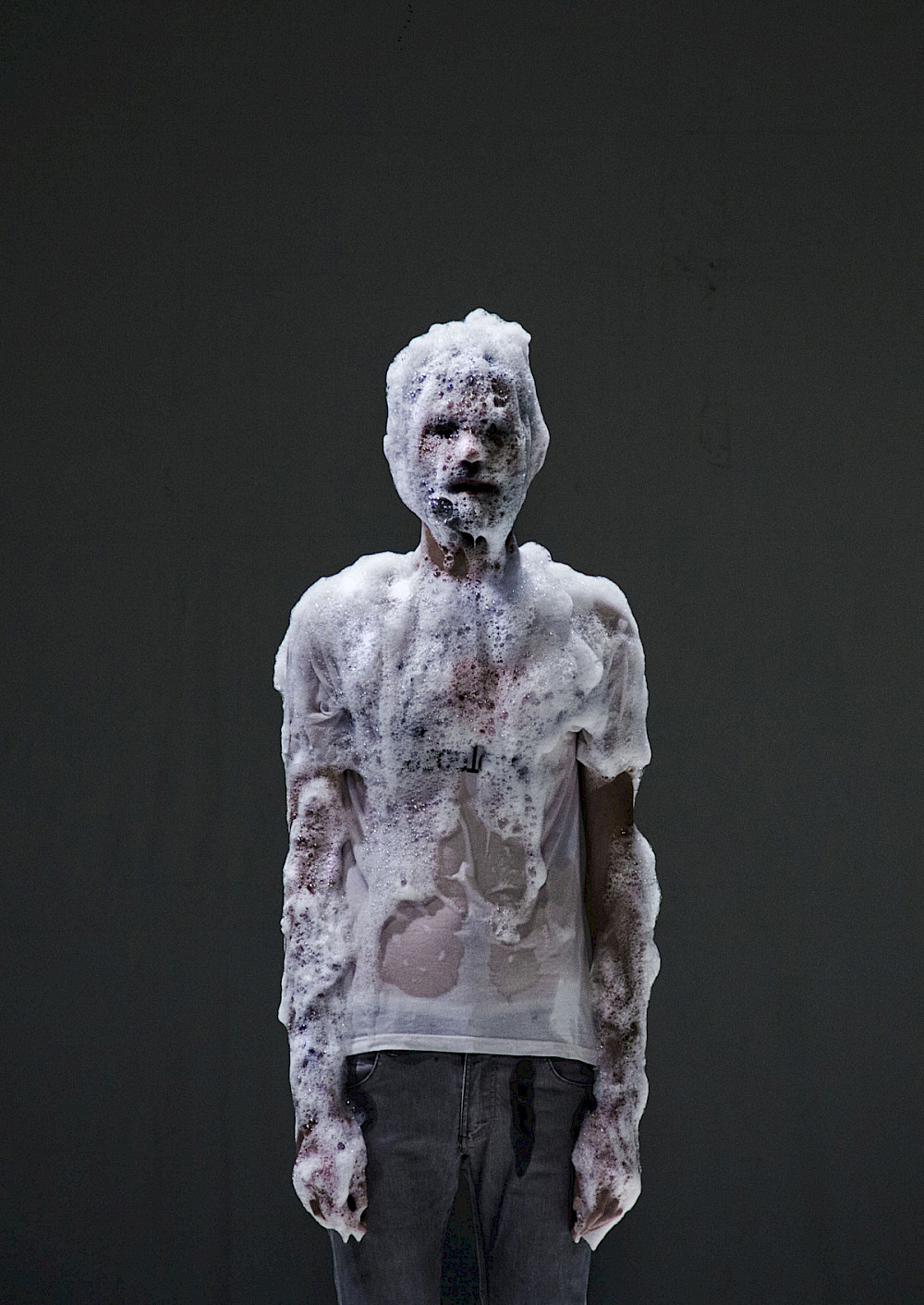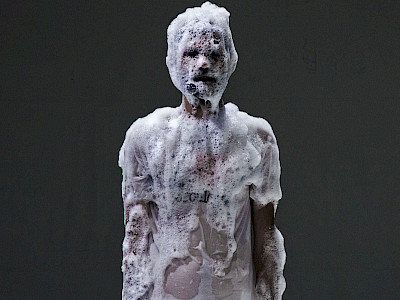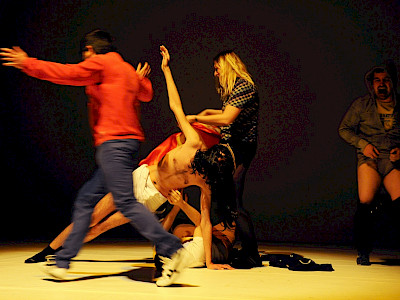26 — 30.05.2015
El Conde de Torrefiel Barcelona
Escenas para una conversación después del visionado de una película de Michael Haneke
performance
Spanish → FR, NL | ⧖ 1h10 | Meet the artists after the performance on 27/05
The writers, musicians, dancers and video makers who make up El Conde de Torrefiel, a collective appearing in Belgium for the first time, are putting together a body of theatre work that draws its strength from confronting various disciplines with one another. In their must-see show Escenas, twelve stories come one after the other. Today’s young Europeans explore anecdotes, fantasies and traumatic experiences that highlight an insidious conflict between what they want, what they do and what they say. This discrepancy at the heart of the individual is also reflected in the staging. The words are more projected than they are spoken, and the actions are often found to be out of step with the story itself. With a great sense of the stage, El Conde de Torrefiel have created a show that ironically and with great acuity poses the question of freedom in 21st-century society, a society in which everyone wants to live according to their instincts while unwittingly being subject to the power of a global diktat they don’t understand. A portrait of an alienated generation.
El Conde de Torrefiel
Our company was conceived as a professional project in 2010, during one of the worst periods in the political and economic life of Spanish democracy. Since that time, there has been a steady decline in the number of contemporary arts festivals in Spain, until the few that remain today can be counted on the fingers of one hand. Companies are closing, the cultural environment is collapsing, and many artists are leaving Spain to seek an artistic setting elsewhere. Many, like us, decided to stay however, and so we had to reinvent ourselves, creating the best new artistic settings for ourselves in order to achieve serious work. This is why the piece we are presenting at the festival addresses this whole politico-economic situation.
The structure of the company is still youthful and flexible. The ways we approach our work vary with each project, and we take a trial-and-error dynamic approach. Although Tanya Beyeler and Pablo Gisbert are the core as artistic directors, together we take a collective approach to our creativity. We have a permanent technical and artistic team, but for each project we bring in others whom we find useful for realising particular ideas, people we love to work with and who can enrich the project by bringing to it their own, different viewpoint. We always work from personal or artistic affinity, choosing performers for who they are, for their most outstanding qualities and creative skills. So we ask them simply to be themselves, and do the best they can. We are not looking for the ability for self-transformation, but rather for total involvement in the project; it is important for us that the people we work with feel that they belong, that they make it their own, which is just what it is. At the proposal stage of a project, it is always just a collection of ideas and concepts, some allusions and many images. At the start, there is chaos, nothing concrete but everything possible. All we do know is the people we want to work with. And through this teamwork, trying things out in rehearsal, the way the performers put the proposals into effect, the work begins to build. We try out many different scenes, improvising all the time, experimenting with many different texts. In fact, the rehearsal process is one of constant exploration. We do not begin to decide or fix on anything until the last fortnight before the first performance, and up until the last day it is still possible for everything to change. We like to think of the artistic team as setting out on an expedition into the desert, where nothing is really safe or secure.
Pablo Gisbert began to write for the dance company La Veronal in 2005, and this led to his interest in theatre. Tanya Beyeler was working for the same dance company, and their collaboration dates from this period, Pablo as playwright and Tanya as actor. Since they both came from the theatre, with a connection to dance, they decided to focus the work of El Conde de Torrefiel on this combination of the two disciplines, on the one hand the text, providing the dramatic structure and on the other, stage movement understood as choreography. We always describe the work of El Conde de Torrefiel as the result of an oscillation between literature, the plastic arts and choreography, and we would now add many more aspects, since we believe that to do theatre just as we like it, the last thing that one should wish to do is theatre.
Our starting point for working on this piece was a formal and aesthetic investigation that places the words and action into conflict, what is said against what is done, through stage techniques such as voices off, projected text or monologues constructed in the third person, and the absence of dialogue. This search continues with time and experience, based on proposals but with more sophisticated strategies developed that open up other paths for us; we now feel in fact that we are at a crossroads, and we do not know where we will go next. Pablo’s present style of writing has changed, and we can see that the way we handle and understand stage time and conflict is now different, at once more abstract and forceful. Even so, the constant theme remains: how people live nowadays.
Escenas para una conversación después del visionado de una película de Michael Haneke
The piece was staged in Barcelona in 2012 in a truly restrained production. At the time we created this piece, we were immersed in the world of fanzines, and we had created our own using a scrapbook of performance ideas (texts, sketches for possible sets, notes for ideas that never saw the light of day). We loved the immediacy of the language of fanzines and comics, the bold and precise outline, accurately grasping the essence of the story in cartoon-form. The fanzines share some of the same forceful brevity that has always attracted us. At this point, the beginning of 2012.
Spain was in a complete crisis, with huge cuts being made and revelations of abuse by a government that did not govern in the interests of its citizens but on behalf of the interests of the most powerful, anonymous and heartless forces. The dismantling of the welfare state, condemning the most vulnerable to insecurity, led to a daily record of little tragedies and stories of desperation, bringing to the forefront widespread, palpable discontent in the everyday life of so many people. Everyone around us was living in a state of incredulity, and speaking out of their anger and uncertainty. This was the reason why we created this fragmented piece, out of this utterly fragmented political reality in which we were living.
This was our third piece. The first, La historia del Rey vencido por el aburrimiento (The story of the king defeated by boredom) was formed of threeshort pieces, three acts portraying a slowed-down, almost imperceptiblemovement with everyday objects, while the rhythm and conflict wereprovided by voice-off or projected text. The second work, Observen cómo el cansancio derrota al pensamiento (Observe how tiredness defeatsthought) is very performative in nature, its device a synthesis of the ideaof text and action brought into conflict. The work consists of a basketballgame running alongside a text spoken by a voice off, where a man and a woman are having another match, an intellectual one this time, of questionsand answers on vital issues. These two elements are hinged togetherby the concept of physical and intellectual “boredom”, eventuallyflowing into a reflection on the boredom with life that grows over thepassage of time. Escenas para una conversación después del visionado de una película de Michael Haneke (Scenes for a conversation after a viewingof a Michael Haneke film) is the outcome of the need to create apiece with a very theatrical format, like the first but able to reproducethe conceptual device of the second. We chose for this to move closer tothe figure of the actor itself. Monologues are spoken by actors to themicrophone, although back-to-back, to maintain the distance with theaudience and focus attention on the abstract movement.
We give all our works broad titles, not aiming at anything specific, but rather offering a suggestion, an invitation to the imagination and finally to the reading of the piece. Michael Haneke appears to have nothing to do with the piece, but in reality he does: there are elements in common with what this cinema director puts into his films. The stories of the piece are presented from the notion of everyday fascism; the relationships of power established in urban, western, capitalist and post-industrial societies. It was a way of reproducing the hegemonic order in daily life, reproducing the total repression that emerges from this order, the cruelty of normalized subjectivities, and the blame, frustration, failure, loneliness and anguish arising from the impossibility of complying with this way of thinking. Finally, living in Barcelona, the content of the stories and the forms are much more Mediterranean and baroque, since this is our reality and our lived environment.
We are working on the production on the basis of two key scenic elements, the first of which is the text, presented in different forms (by actors, projected text or voice) always with the clear objective of understandable communication with the spectator. The texts are literary, often monologues, expressing ideas in an enjoyable way to unravel the complexities of thought. The language is simple and direct, articulated to create images of daily life, our present reality. The political load carried by the texts is rooted in daily life, presenting everyday conflicts in order to understand and handle our known reality: Europe, 2015.
In the second place, in contrast to the specific text itself, we use abstract movement and action as a scenic element, not just by contrasting what is said and what is done, but also in terms of form. The behaviour of the bodies is often close to the language of dance; not seeking realistic forms, it experiments with other possible realities of meaning and representation of subjectivity. The movement on the stage is calculated, organised aesthetically and with a touch of naivety. We seek to seduce the spectators, making them complicit so that the images may be completed through imagination. We can thus plot a two-way line of communication based on the mystery of the possible. Our intention is to achieve direct involvement based on play: the play of possible realities.
Concept & direction
El Conde de Torrefiel
Text & dramaturgy
Pablo Gisbert
With
David Mallols, Isaac Forteza, Quim Bigas, Mario Pons-Macià, Tanya Beyeler
Lighting
Marcela Prado
Technician on tour
Isaac Torres
Technical director
Octavio Más
Sound
Rebecca Praga
Translation
Cristina Vinuesa, Nicolas Chevallier (FR), Nika Blazer (EN)
Production
Tanya Beyeler
Photos
Mara Arteaga, Edu Pérez
Presentation
Kunstenfestivaldesarts, Beursschouwburg
Production
El Conde de Torrefiel (Barcelona)
With the support of
Encuentros de Magalia 2011, Adriantic / Antic Teatre Residency, Institut Ramón Llull, INAEM - Ministerio de Cultura de España, Departament de Cultura Generalitat de atalunya
Performance in Brussels supported by
Cultural Office of Spanish Embassy in Brussels





